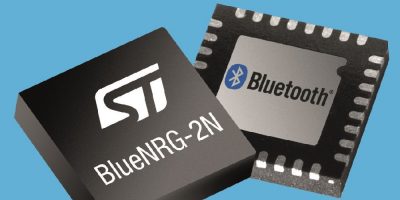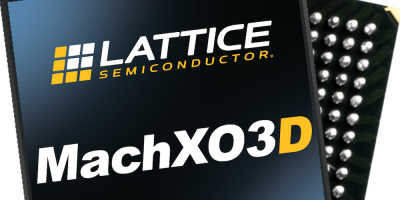Combining Bluetooth 5.0 performance with enhanced privacy and security features, the BlueNRG-2N network processor is convenient and scalable, says STMicroelectronics.
The Bluetooth 5.0-certified network coprocessor is pre-programmed and ready for connecting to a host controller to provide Bluetooth connectivity. It simplifies the manufacture of products, says ST, and also allows the developer to scale the performance, features and cost of the host system independently. It can be used in a range of products such as smart medical wearables, PC peripherals, remote controls, lighting, industrial and home automation devices, and allows designers to optimise their choice of microcontroller to meet specific model requirements.
The Bluetooth enhancements featured in BlueNRG-2N include support for data length extension, which accelerates over the air (OTA) firmware updates by as much as 2.5 times, claims ST, and raises data transfers to 700kbit/s at the application level. The BlueNRG-2N also has support for Bluetooth LE Privacy 1.2, which allows it to change address frequently without host-processor involvement to prevent unwanted tracking and with minimal impact on system power consumption.
BlueNRG-2N is programmed with a digitally signed Bluetooth LE stack, which saves manufacturing costs yet maintains the design flexibility to upgrade via OTA updates. For cyber security, built-in image authentication technology always checks the stack before starting to allow only signed firmware images to run.
Power consumption is lower compared with previous BlueNRG generations, with low transmit and receive current and drawing just 900nA in shutdown mode with the Bluetooth Low Energy stack running. At the same time, the device maintains robust radio performance, with +8dBm programmable RF output power and up to a 96dB link budget.
BlueNRG-2N is the latest member in ST’s BlueNRG family of Bluetooth Low Energy chips for wireless system design. It is the dedicated network co-processor within the BlueNRG family. It shares key features with the BlueNRG-2 Bluetooth 5.0-certified SoC, which also contains a programmable Arm Cortex-M0 microcontroller to host the main application and Bluetooth connectivity on the same device. ST Microelectronics also offers developers the STM32 online development environment (ODE), which includes the STM32CubeMX GUI plug in, designed for developers to kick-start projects.
BlueNRG-2N is in full production and is included in ST’s 10-year industrial product-longevity program. The devices are available in a 2.66 x 2.56mm WLCSP34 chip-scale packages (BlueNRG-234N) or 5.0 x 5.0mm QFN32 (BlueNRG-232N).







